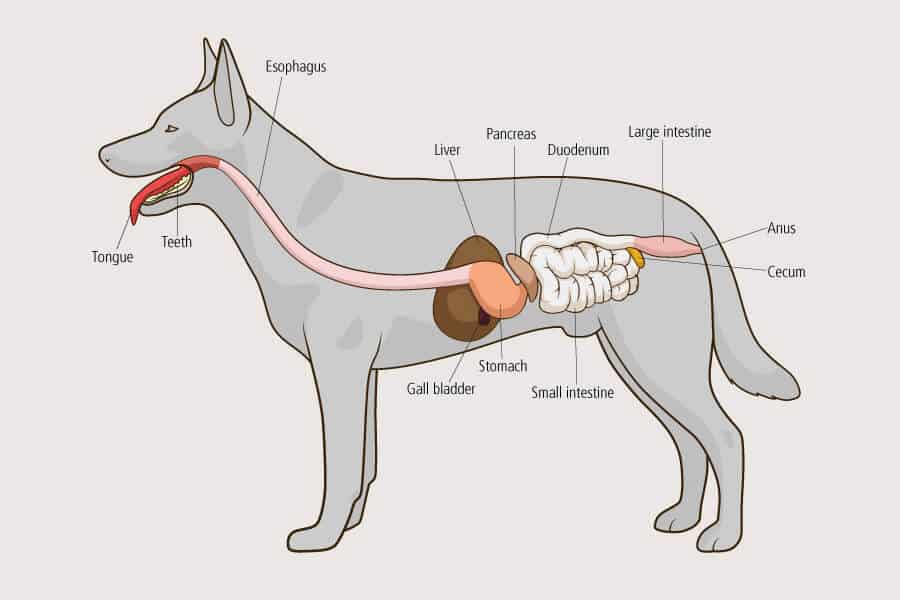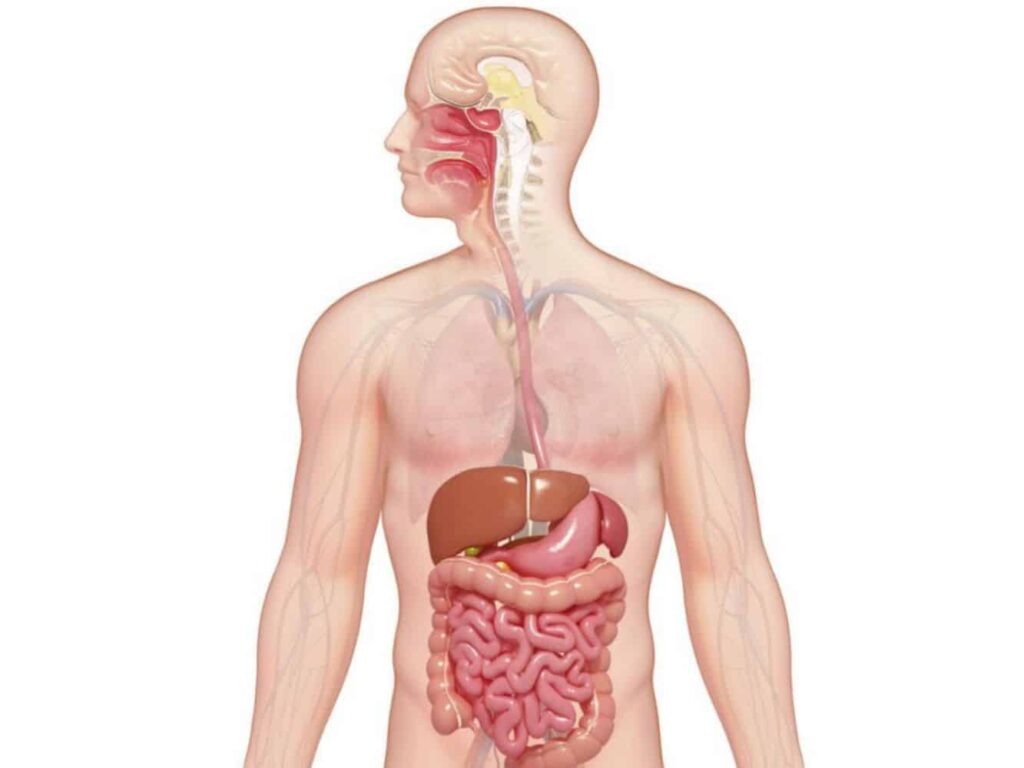Your dog’s stomach is a muscular sac that is lined with several glands that aid in the digestion of the food they consume.
When food enters the stomach, it is mixed with digestive fluids, which begin the process of breaking down proteins and other nutrients.
The stomach also acts as a storage space for food, and it contracts to move food further down the digestive tract.
Dogs have a relatively short digestive tract, which means that they can digest food quickly.
This is one of the main differences between your stomach and that of your furry friend.
The other is size.
How big is your dog’s stomach? How much food can it carry? How long does food stay in your pup’s stomach?
Let’s find out…
Dog Stomach Size

Dogs come in all shapes and sizes, so it’s no surprise that their stomachs vary in size as well.
Generally speaking, a dog’s stomach can hold about 1-4 cups of food per meal.
However, this amount will vary depending on the breed and weight of the dog.
For example, a small Chihuahua will have a much smaller stomach than a large German Shepherd.
In other words, the size of a dog’s stomach is mostly determined by the breed/size of the dog in question.
A. Large Dog’s Stomach

Large dog breeds (e.g. German Shepherds, Golden Retrievers, Rottweilers, and Doberman Pinschers) have much larger stomachs in comparison to their smaller canine cousins.
In fact, some large breeds have stomachs that can hold up to 4 times the amount of food that a small dog’s stomach can.
This is because big dogs generally have more muscle mass and therefore require more calories and nutrients to fuel their bodies.
A large dog’s stomach can easily hold 4 cups of food at a time. However, this doesn’t mean that they should be eating all the time.
Additionally, like all dogs, big breeds need to have a balanced diet that is tailored to their individual needs.
Overfeeding a big dog can lead to obesity and a host of other health problems down the line.
B. Small Dog’s Stomach

Small breeds (e.g. Chihuahuas, Yorkshire Terriers, Pomeranians, and Toy Poodles) have much smaller stomachs that can only hold a limited amount of food at any one time.
On average, a small dog’s stomach can only hold ¼ a cup of food at a time. This is because they have less muscle mass and therefore don’t need as many calories to fuel their bodies.
Because small dogs’ stomachs can’t hold as much food as the large breeds, it is important to choose high-quality food that is specifically designed for small breeds.
They should also be fed only a few times a day to avoid overstressing their digestive system.
It’s also important to choose a high-quality food that is specifically designed for small breeds as they have different nutritional needs.
Related Post: How Big is a Chihuahua Stomach?
C. Medium-Sized Dog’s Stomach

Medium-sized breeds (e.g. Labrador Retriever, Beagle, and Boston Terrie) fall somewhere in between the large and small breeds when it comes to stomach size.
They have stomachs that are big enough to hold a decent amount of food, but not so large that they are at risk of overeating.
As with all dogs, it’s important to feed a medium-sized breed a balanced diet that meets their individual needs.
They should be fed 1-2 times a day, and the amount of food will depend on their activity level, age, and weight.
Dog Stomach Size Vs Human
Have you ever wondered why your dog can eat just about anything, while your stomach will start to hurt if you eat too much?
It turns out that there are some big differences between human and dog stomachs.
For one, dogs have a much higher acidity level in their stomachs, which helps them to break down food more effectively.
They also have a shorter digestive tract, which means that food passes through their system more quickly.
However, the biggest difference is in the size of the stomach.
A human stomach typically holds only one quart of food while a dog can hold as much as four quarts depending on the breed.
Another difference is that dogs have a larger stomach in proportion to their size.
While a human’s stomach is just as big as a clenched fist, a dog’s is about the size of their head.
This difference in size means that dogs can consume a larger amount of food in a single sitting than humans can.
So, next time your dog begs for a bite of your dinner, remember that their stomach is built for it!
Learn more about the differences between our stomachs and digestive systems and our pups’ in this amazing video by Questions For Science:
By the way, we’ve mentioned that our (human) stomachs are just as big as our clenched fists. What about our canine friends? Are their stomachs comparable to their paws as well?
Dog Stomach Size Vs Paw Size

A lot of people believe that a dog’s stomach is about the same size as its paw.
This may be informed by the fact that the stomach of humans is the size of a clenched fist.
However, this isn’t necessarily the case for dogs because they have a larger stomach than humans.
As aforementioned, on average, a dog’s stomach is about the same size as its head. This would mean that a dog’s stomach is way larger than its paw.
Also, by this standard, the size of the stomach will depend on the size of the dog—just the same way smaller dogs have smaller heads and vice versa.
Dog Stomach Capacity

Dogs have a stomach capacity that is about 1/4 to 1/5 the size of their total body volume.
For example, a 30-pound dog has a stomach capacity of about 6 cups. This means that a dog can eat a large amount of food at one time, but it also means that they are more likely to suffer from digestive issues if they eat too much.
Dogs also have a high rate of gastric emptying, which means that their stomachs empty out more quickly than human stomachs.
This allows them to digest food more efficiently, but it also means that they are more likely to vomit if they eat too much too fast.
And speaking of the rate of emptying, there’s one question that many dog parents keep asking:
How Long Does A Dog Have A Full Stomach?

For most dogs, it takes about 8-10 hours for the food to move through the entire digestive process.
However, this can vary depending on the size of the dog and the type of food that was eaten.
For instance, a large dog may take longer to digest a meal than a small dog, and dry food is generally digested more quickly than wet food.
In addition, exercise can also affect how long it takes for food to move through the stomach, as movement helps to speed up the digestive process.
As a result, there is no one-size-fits-all answer to this question.
However, if you notice that your dog is having difficulty digesting their food, or if they seem to be hungry all the time, it’s important to speak to your veterinarian, as this could be a sign of an underlying medical condition.
We also have a post that can answer some of your questions, especially with regards to problems with food digestion. Feel free to check it out: Why Is My Dog Throwing Up Undigested Food Hours After Eating?
Is It Normal For Dogs To Have Big Tummy?

It’s not unusual for dogs to have big tummies. In fact, puppies will almost always have a bulging stomach when they are full.
That said, some medical conditions, such as bloat, can cause a dog’s stomach to swell to dangerous levels. Bloat is also referred to as GDV (gastric dilatation-volvulus).
A bloated stomach can put pressure on the dog’s other organs, and can even be life-threatening.
GDV is caused by a combination of factors, including overeating, drinking too much water too quickly, and exercising immediately after eating.
Studies have shown that some breeds are more susceptible to GDV than others.
Examples of these breeds include:
- Old English Sheepdogs
- Irish Setters
- Doberman Pinschers
- Great Danes
- Basset Hounds
- Saint Bernards
- Standard Poodles
- Weimaraners
- Gordon Setters
Bloating can progress quickly, and can be fatal if not treated promptly.
If you’re concerned that your dog’s stomach may be bloated, it’s important to take them to the vet right away.
Quick Tips
I. How to Feel a Dog’s Stomach

While it may seem daunting, feeling a dog’s stomach is not difficult and can be very helpful in determining their health.
The first step is to find the right spot—the stomach is located just behind the ribcage, and should not be too difficult to find.
Once you have located the stomach, gently place your hand on it and begin to rub in a circular motion.
You should be able to feel the dog’s ribs beneath your fingers.
If you cannot feel the ribs, or if you feel any lumps or bumps, it is important to consult a veterinarian.
However, if the stomach feels smooth and firm, then the dog is likely healthy.
Feeling a dog’s stomach regularly can help you to catch any potential problems early on, and ensure that your furry friend remains healthy and happy.
II. How to Massage a Dog’s Gas

One of the best ways to massage your dog’s gas is to start with long, slow strokes down their back.
You can then focus on specific areas that seem to be causing them discomfort.
Gently massage their tummy in a clockwise direction using your fingertips and fingers.
You can also try short, firm strokes along their sides.
If your dog has any knots or tight muscles, you can gently work these out with your fingers.
Be sure to ask your dog if they are enjoying the massage and stop if they show any discomfort.
As always, consult with your veterinarian if you have any concerns about your dog’s health.
Summary
The size of your dog’s stomach will depend on its size/breed.
On average, your dog’s stomach will be the same size as its head.
This means that the smaller dogs will have smaller stomachs whereas the larger ones will also have larger stomachs.
However, keep in mind that it is also possible for your dog to be bloated and this can be fatal if it is not taken care of.
If you are unsure, it is best to consult with a vet just to be safe.
As an Amazon Associate, we may receive a small commission from qualifying purchases but at no extra cost to you. Learn more. Amazon and the Amazon logo are trademarks of Amazon.com, Inc, or its affiliates.



